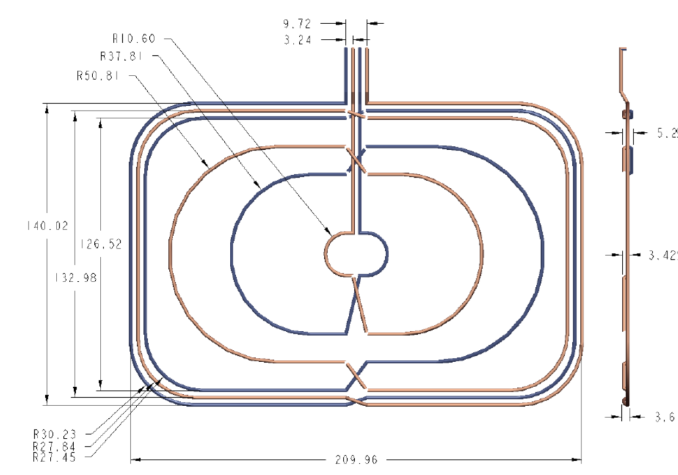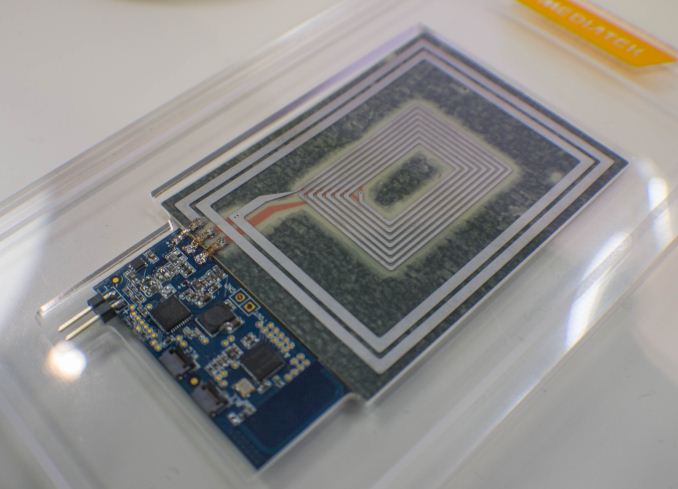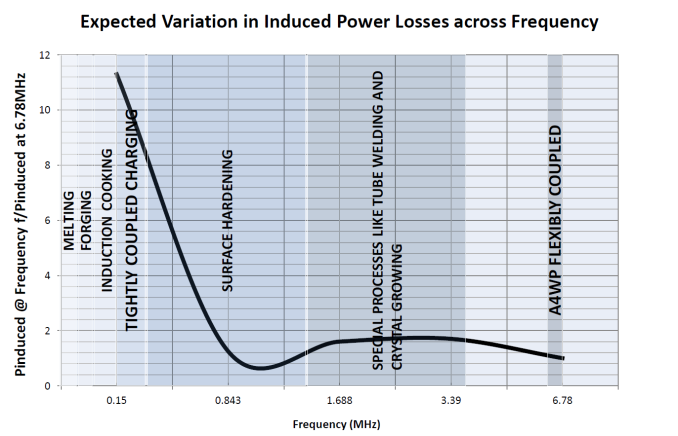The State of Wireless Charging Standards in Mobile
by Andrei Frumusanu on April 2, 2015 8:00 AM ESTRezence Resonance Charging
Earlier we saw the distinction between tightly coupled (TC) and loosely coupled (LC) induction charging systems. While A4WP’s Rezence system is called a magnetic resonance charging system, the basic principle is still based on magnetic induction. The critical difference between Qi and Powermat standards is that it is a Rezence is based on a loosely coupled coil system.
Inductive power frequencies and use-cases (Source)
A4WP systems work on a much higher frequency compared to tightly coupled systems such as defined by PMA and WPC. Rezence’s operating frequency is defined on a strict 6.78MHz (±15kHz) band compared to the 110-357kHz range that Qi and Powermat operate in.
Instead of a tight coil on the transmitter and receivers, we see the usage of a specifically shaped resonator designs. An A4WP transmitter has typically larger footprint than Qi or Powermat designs, with various classes of designs available depending on power requirement. Currently the widely adopted one is the Class 3 transmitter which has a size of 204x146mm and meant for smartphone device use-cases.


A4WP Class 3 spiral type 235-135 power transmit resonator (Source 1, Source 2)
The class system allows A4WP for a variety of size power transmitter unit (PTUs) and power receiving unit (PRUs) resonator coil systems depending on the number of devices and power you are targeting to charge. The class 3 PTU supports up to 16W transmit power.
| PTU Class | Maximum transmission in power |
Minimum PRU Support |
| Class 1 | TBD | >1 x Category 1 |
| Class 2 | 10W | 1 x Category 1, 2, or 3 |
| Class 3 | 16W | 2 x Category 1,2, or 3, or 1 x Category 4 |
| Class 4 | 22W | 3 x Category 1, 2, or 3, or 1 x Category 4 |
| Class 5 | TBD | TDB |
| PRU Category | Maximum reception out power |
Example Applcations |
| Category 1 | TBD | BT headset |
| Category 2 | 3.5W | Feature Phone |
| Category 3 | 6.5W | Smart Phone |
| Category 4 | TBD | Tablet |
| Category 5 | TBD | Laptop |
The current PRU categories are mainly defined for feature phone and smartphone devices with output powers of respectively 3.5 and 6.5W. We should be seeing class 3 devices as the most prevalent category implemented in smartphones in the near future. A class 3 PTU can charge at least two class 3 PRUs at full power, which should be sufficient for most use-cases.
A4WP WPT multi-device charging architecture (Source)
As mentioned before, the LC design of the Rezence charger allows for multiple receivers for a single transmitter, enabling a "star network" of PRUs for each PTU.
While Qi and Powermat respectively use either modulation on the power signal and RFID for communication between the transmitter ans receiver devices, Rezence work with a Bluetooth Low Energy (BLE) connection between all the different actors. There is no device pairing involved as communication is done over GATT (Generic Attribute Profile), a BLE feature.
At MWC2015 multiple vendors were demonstrating their A4WP implementations and chargers, and it was much more impressive to see them in action compared to the TC systems such as Qi and Powermat. Mediatek had a vertically standing Rezence charger which was demonstrated on a Galaxy S4 with custom backplate integrating Mediatek's tri-standard charging solution and powering the device via the dedicated power pins.
Practically, Rezence also seems to be the better solution as one doesn't have to deal with alignment of the device on the charging surface. Charging surfaces can vary in size and have an advantage of reduced complexity as it still remains a single resonator coil, where as Qi requires multiple overlapped coils to achieve the same effect and Powermat doesn't allow such flexibility in the first place.
Closing Thoughts
Having shed a bit more light on the difference and characteristics of the three main charging standard today, the question is on how the future of wireless charging will look. There is an undisputable battle of politics going on between the different standards associations, with each wanting to have their say and their own solutions to the wireless power transfer problem. Though right now the odd man out in all of this is the PMA, as it's hard to argue that Powermat brings any tangible advantages over Qi, not to mention it's a much less widespread standard.
Rezence from the A4WP on the other hand seems to be promising. The A4WP sees tightly coupled systems as first-generation technology that will in the future be replaced by loosely coupled charging implementations such as Rezence. I don't think the lesser charging efficiency will be something that people will mind as the practicality improvements clearly outweigh the disadvantages. The PMA-A4WP merger is seen as a technology swap as the A4WP gains access to a tightly coupled standard and the PMA gets access to a loosely coupled standard.
Meanwhile the WPC is working on its own resonance based loosely coupled system to compete with Rezence, but it's still in the development and we don't yet have much information on it.

MediaTek's tri-standard charging solution demonstration board
IC designers are going forward with tri-standard compatible solutions for wireless charging and that's what I envison will be the the aim for most device manufacturers who will want to include wireless charging into their products. This solves the device compatibility issue, but doesn't solve the problem completely as not all devices will be able to adopt it due to differing form factors. Rezence here again offers the best offering for form factor diversity, power transfer and charger interoperability. Though with the number of factions involved in this battle, it's not necessarily a given that this will be a battle won by technology as opposed to politics.
Ultimately the wireless charging ecosystem has changed a lot over the last few years, and things could again change drastically over the next few years, so nobody knows for sure in which direction the market will shift. We'll be sure to keep an eye on WPT in the future and cover any emerging news on the topic.












90 Comments
View All Comments
Samus - Monday, April 6, 2015 - link
...calmly folds tinfoil hat. places on head.theduckofdeath - Sunday, April 12, 2015 - link
"I slept through physics in school, so I think all radiation causes cancer"....-blanarahul
blanarahul - Thursday, April 2, 2015 - link
" Taking out your charger and looking for a free socket can prove to be hassle."That problem applies to wireless charging too.
The main problem we face is the lack of 'standardized charging' and NOT 'standardized wireless charging'. But that will hopefully be fixed by USB Type C. It can be used to charge anything from smart watches to laptops.
theduckofdeath - Sunday, April 12, 2015 - link
You almost got it right, just the wrong way around. I'm all with Samsung on this. Wireless charging IS what will charge everything from laptops to watches in a few years. USB type C is the wrong solution, especially for watches which are supposed to be a lot more water resistant than things like phones.phoenix_rizzen - Sunday, April 5, 2015 - link
"Looking for a free outlet for the charger" is a red herring.If the wireless charging mat is always plugged in and sitting in one spot waiting for a phone... then why can't you just leave the wired charter plugged in all the time in the same spot, waiting for a phone?
If you never leave the wired charger plugged in, why would you leave the wireless mat plugged in?
Anything you can do with over can be done with the other. The only difference is the maybe 2 second to connect the cable. For devices where the charging port is failing, this is a bonus. For devices where the charging port isn't failing, this is a wash.
Shadowmaster625 - Thursday, April 2, 2015 - link
If you put a red sticker on one side of the cable connector to easily indicated which side goes where, then yes it usually does take two seconds. Sometimes it only takes one second.Lord of the Bored - Friday, April 3, 2015 - link
You still have to pick the cable up, connect it to the device, then set the device down. Wireless charging is literally just "set device down".I don't really think all those power cables are a huge issue, or that the effort of plugging in a cable is killing baby seals or anything. It's a minor aesthetic problem at worst.
The biggest problem(if you can call it that) is that USB cables only go in one way. I miss ye olde barrel connectors. I SUPPOSE this means I'm saying Apple did something right, though I consider Lightning to be a great idea implemented (exceptionally) poorly. That the cable has four ICs in it(yes, really!) and a couple of fuses is partially proof that the iPhone 5 connector has serious flaws(and partially an attempt at securing cash flow by forcing accessories AND CABLES to be licensed, but that's neither here nor there).
JonnyDough - Saturday, April 4, 2015 - link
Just goes to show how lazy we've really become.Stuka87 - Thursday, April 2, 2015 - link
It is if you have an iPhone. The lightning connector is just awesome. It can go in either direction, and slides in very easily. WAY better than micro-USB.mr_tawan - Friday, April 3, 2015 - link
With the only condition which is ... all of your devices are iOS and equipped with Lightning. If you happens to use multiple chargers with multiple device mixed with those microUSB you'd ended up with having hassle with cables and adapters.I'd love to see USB-C in the next iPhone, though those Lightning-device owner would cry a lot....